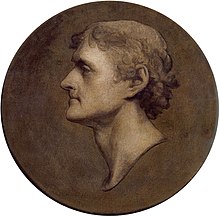Madison Hemings
[1] Born into slavery, according to partus sequitur ventrem, Hemings grew up on Jefferson's Monticello plantation, where his mother was also enslaved.
After some light duties as a young boy, Hemings became a carpenter and fine woodwork apprentice at around age 14 and worked in the joiner's shop until he was about 21.
At the age of 68, Hemings claimed the connection in an 1873 Ohio newspaper interview, titled, "Life Among the Lowly," which attracted national and international attention.
Following renewed historical analysis in the late 20th century, and a 1998 DNA study (completed in 1999 and published as a report in 2000)[2] that found a match between the Jefferson male line and a descendant of Sally Hemings' youngest son, Eston Hemings, the Monticello Foundation asserted that Jefferson fathered Eston and likely her other five children as well.
[3] After Hemings and his younger brother Eston were freed, they each worked and married free women of color; they lived with their families and mother Sally in Charlottesville until her death in 1835.
[9][10] According to Hemings's memoir, his mother told him that his father was Thomas Jefferson, and that their relationship had started in Paris, where he was serving as a diplomat,[11] having been appointed the Minister to France in 1784.
[12] Pregnant, she agreed to return with Jefferson to the United States based on his promise to free her children when they came of age at 21.
[14] He compared Jefferson's affectionate treatment of his white grandchildren to that of the Hemings children, who were not treated with affection or partiality.
It was the maternal descent rule of partus sequitur ventrem (the offspring of a slave belongs to the owner of the mother) that enslaved a person — if the maternal slave line was unbroken by legal manumission.Our canon considers two crosses with the pure white, and a third with any degree of mixture, however small, as clearing the issue of the Negro blood.
But observe, that this does not reestablish freedom, which depends on the condition of the mother, the principle of the civil law, partus sequitur ventrem being adopted here.Hemings was named for Jefferson's close friend, James Madison.
[21] Unlike other enslaved children, they had light work, were able to stay near their mother, and knew that they would be freed upon coming of age.
[5][11] Jefferson ensured that Harriet was given $50 (equivalent to $1,145 in 2023) for her journey to Washington, D.C.[26] Because of their light skin and appearance (they were 7/8 European or octoroon), both identified with the white community and probably changed their names.
Slave catchers were known to kidnap free black people and sell them into slavery, as demand and prices were high in the Deep South.
[9] (In September 1831, in his mid-twenties, Madison Hemings was described in a special census of the State of Virginia as being: 5 feet 7 3/8 inches high light complexion no scars or marks perceivable".
Forty-two years later, a journalist described him as "five feet ten inches in height, sparely made, with sandy complexion and a mild gray eye.
Beverly and Harriet left Monticello to go North when they were both around twenty-one years of age, but Madison and Eston were freed by Jefferson's will after he died.
[41] Largely as a result of revived interest in this case following Gordon-Reed's book, a Y-DNA analysis of Carr, Jefferson and Hemings descendants was conducted in 1998.
It showed no match between the Carr male line, proposed for more than 150 years as the father(s), and the one Hemings descendant tested.
[42] It did show a match between the Y-DNA haplotype of the Jefferson male line and the Hemings descendant, which is a rare type.
[42][43] Since 1998 and the DNA study, which affirmed the historical evidence, many historians have accepted that the widower Jefferson had a long, sexual relationship with Hemings, and fathered six children with her, four of whom survived to adulthood.
Beverley Hemings' descendants have been lost to history, as he apparently changed his name after moving to Washington, DC and passing into white society.
[50] Their son, Frederick Madison Roberts, named for his maternal grandfather, was college-educated and became a businessman in partnership with his father.
William Beverly Hemings served in a white regiment--the 73rd Ohio--in the Civil War and died alone in a Kansas veterans hospital in 1910.
[32]Many of the Hemings' descendants who remained in Ohio were interviewed in the late twentieth century by two Monticello researchers as part of the Thomas Jefferson Foundation's "Getting Word" project.
[32] In 2010 Shay Banks-Young and Julia Jefferson Westerinen, descendants of Sally Hemings who identify as black and white, respectively, were honored together with David Works, a descendant of Martha Wayles Skelton Jefferson, with the Search for Common Ground award for "their work to bridge the divide within their family and heal the legacy of slavery.



